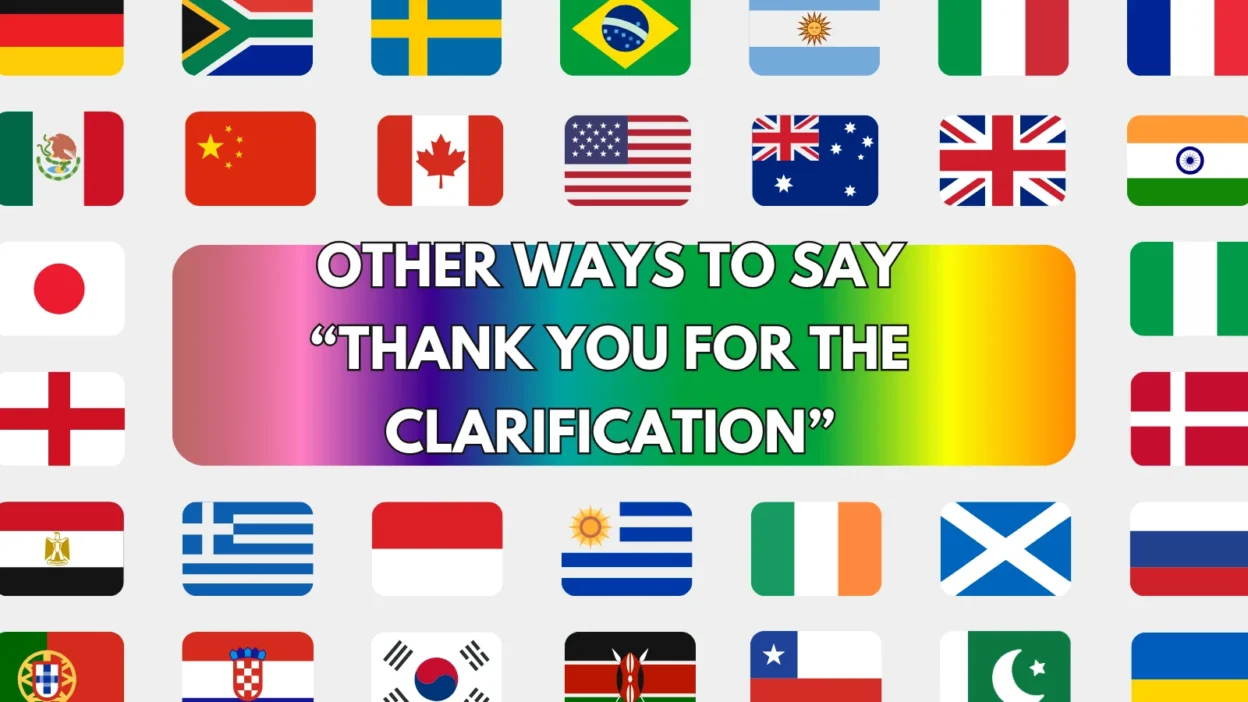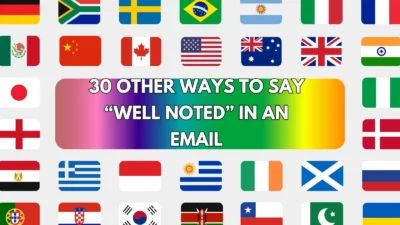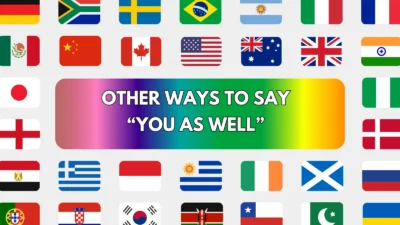The phrase “thank you for the clarification” is polite and professional — perfect when someone explains or clears up confusion. However, using the same expression repeatedly in emails, meetings, or chats can sound monotonous or overly formal.
Here’s a guide to 30 natural and professional alternatives to say “thank you for the clarification” — suitable for workplace communication, customer service, and friendly exchanges.
1. Thanks for Explaining
Meaning: A simple, direct way to show appreciation for an explanation.
Example: Thanks for explaining the process so clearly.
Tone: Friendly and informal.
Best Use: Everyday workplace conversations or casual emails.
2. I Appreciate the Clarification
Meaning: A polite, formal way to express gratitude for a detailed explanation.
Example: I appreciate the clarification — that helps a lot.
Tone: Professional and sincere.
Best Use: Business emails, client communication.
3. Thanks for Clearing That Up
Meaning: A relaxed and conversational way to thank someone for resolving confusion.
Example: Thanks for clearing that up — now it makes perfect sense.
Tone: Casual and friendly.
Best Use: Team chats, informal emails.
4. Thanks for Making That Clear
Meaning: Shows gratitude for simplifying or confirming something.
Example: Thanks for making that clear before the meeting.
Tone: Warm and professional.
Best Use: Workplace conversations, meetings.
5. I’m Grateful for the Explanation
Meaning: A more heartfelt and formal way to express thanks.
Example: I’m grateful for the explanation — that helps me understand better.
Tone: Courteous and respectful.
Best Use: Formal emails, senior communication.
6. That Helps a Lot, Thanks
Meaning: Appreciates the usefulness of the clarification.
Example: That helps a lot, thanks for your time.
Tone: Friendly and conversational.
Best Use: Quick replies, informal communication.
7. Thanks for Shedding Light on That
Meaning: A creative and slightly figurative way to say thank you.
Example: Thanks for shedding light on that — it was a bit confusing before.
Tone: Friendly and expressive.
Best Use: Team conversations, training sessions.
8. I Appreciate the Detailed Explanation
Meaning: Acknowledges that someone took extra time to explain thoroughly.
Example: I appreciate the detailed explanation — that clears things up perfectly.
Tone: Professional and formal.
Best Use: Business or academic communication.
9. Thanks for Walking Me Through It
Meaning: Expresses gratitude for step-by-step guidance.
Example: Thanks for walking me through it — now I understand everything clearly.
Tone: Warm and grateful.
Best Use: Mentorship, training, or helpdesk situations.
10. That Makes Sense Now, Thanks
Meaning: Shows that you’ve understood after someone explained.
Example: That makes sense now, thanks for the clarification.
Tone: Polite and conversational.
Best Use: Meetings, quick replies.
11. Thanks for the Insight
Meaning: Appreciates an explanation that added value or new understanding.
Example: Thanks for the insight — that’s very helpful.
Tone: Polished and professional.
Best Use: Work emails, feedback sessions.
12. I’m Glad You Explained That
Meaning: Warmly acknowledges the other person’s effort to clarify.
Example: I’m glad you explained that — it makes more sense now.
Tone: Friendly and conversational.
Best Use: Informal chats, workplace conversations.
13. Appreciate You Taking the Time to Explain
Meaning: Thanks someone for the effort they made to clarify.
Example: I really appreciate you taking the time to explain everything.
Tone: Respectful and thoughtful.
Best Use: Emails to colleagues or superiors.
14. That Clarified Everything, Thanks
Meaning: Confirms that confusion is gone.
Example: That clarified everything, thanks for your help.
Tone: Friendly yet professional.
Best Use: Email replies or meetings.
15. Thanks for Pointing That Out
Meaning: Acknowledges someone correcting or highlighting a detail.
Example: Thanks for pointing that out — I missed that part earlier.
Tone: Appreciative and humble.
Best Use: Work discussions, feedback exchanges.
16. I Understand Now, Thanks
Meaning: Indicates comprehension after receiving clarification.
Example: I understand now, thanks for explaining.
Tone: Clear and polite.
Best Use: Professional and educational settings.
17. That’s Much Clearer, Thanks
Meaning: Highlights that the explanation improved understanding.
Example: That’s much clearer, thanks for breaking it down.
Tone: Friendly and engaging.
Best Use: Informal meetings or text exchanges.
18. Thanks for the Update
Meaning: Shows appreciation for receiving clarification through new info.
Example: Thanks for the update — that clears up my confusion.
Tone: Polite and concise.
Best Use: Workplace communication, projects.
19. I Appreciate the Additional Context
Meaning: Thanks someone for providing helpful background information.
Example: I appreciate the additional context, it gives me a better picture.
Tone: Professional and composed.
Best Use: Emails, reports, project discussions.
20. I Value Your Explanation
Meaning: Respectfully recognizes someone’s input and effort.
Example: I value your explanation — it’s made things much clearer.
Tone: Formal and sincere.
Best Use: Communication with clients or senior colleagues.
21. Thanks for the Heads-Up
Meaning: Shows gratitude for being informed early or clearly.
Example: Thanks for the heads-up, I’ll make sure to adjust accordingly.
Tone: Casual and polite.
Best Use: Workplace conversations, friendly emails.
22. I Appreciate You Clearing That Up
Meaning: Warm and personal acknowledgment of the clarification.
Example: I appreciate you clearing that up for me.
Tone: Polite and natural.
Best Use: Informal and semi-formal settings.
23. Thanks for Addressing That
Meaning: Expresses gratitude when someone resolved a confusion or concern.
Example: Thanks for addressing that question — it was on my mind too.
Tone: Professional and appreciative.
Best Use: Meetings, follow-up emails.
24. That Explanation Really Helped
Meaning: Directly states that the clarification was useful.
Example: That explanation really helped — thank you so much.
Tone: Warm and genuine.
Best Use: Mentorship, team discussions.
25. Thanks for Following Up
Meaning: Acknowledges someone clarifying after a previous discussion.
Example: Thanks for following up — the clarification helps a lot.
Tone: Polite and professional.
Best Use: Email communication.
26. I’m Glad You Cleared That Up
Meaning: Expresses relief and gratitude.
Example: I’m glad you cleared that up — I was a bit confused before.
Tone: Conversational and polite.
Best Use: Informal chats or teamwork.
27. Thanks for Setting Things Straight
Meaning: Informal yet confident acknowledgment.
Example: Thanks for setting things straight about the timeline.
Tone: Friendly and conversational.
Best Use: Team discussions or informal meetings.
28. That Explanation Was Perfect, Thanks
Meaning: Compliments someone’s clarity and helpfulness.
Example: That explanation was perfect, thanks for taking the time.
Tone: Warm and encouraging.
Best Use: Peer communication or thank-you notes.
29. Appreciate the Quick Clarification
Meaning: Shows gratitude for a prompt response.
Example: Appreciate the quick clarification, that saves me time.
Tone: Efficient and professional.
Best Use: Work emails, customer support.
30. Thanks, That Cleared Up My Confusion
Meaning: Simple and genuine acknowledgment of understanding.
Example: Thanks, that cleared up my confusion completely.
Tone: Friendly and clear.
Best Use: Everyday communication.
Conclusion
The phrase “thank you for the clarification” is perfectly fine but can sound robotic if overused. Alternatives like “thanks for clearing that up,” “I appreciate the explanation,” or “that makes sense now” add warmth and variety to your communication.
Use formal alternatives like “I appreciate the additional context” in business emails and casual ones like “thanks for explaining” in everyday chats.
Choosing the right tone helps you sound professional, approachable, and genuinely thankful — making every conversation smoother and more human.



